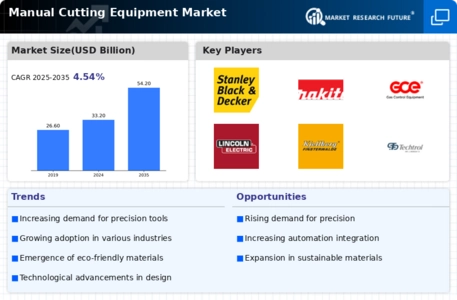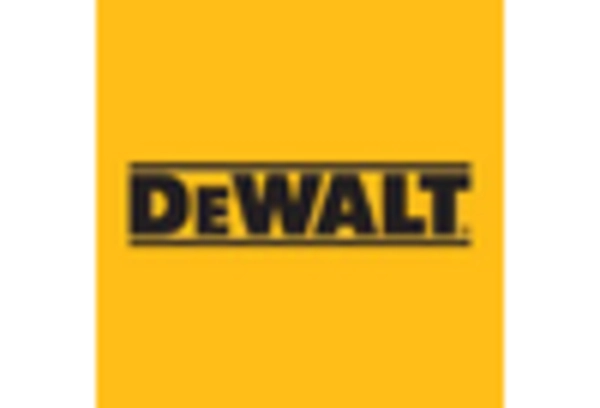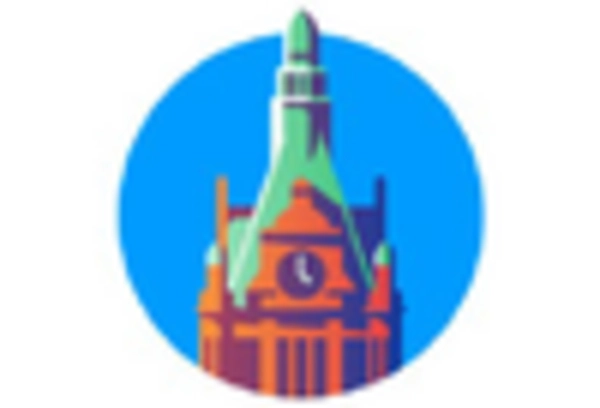Increased Demand for Precision Tools
The Manual Cutting Equipment Market experiences heightened demand for precision tools, driven by industries such as textiles, woodworking, and metalworking. As manufacturers seek to enhance product quality and reduce waste, the need for accurate cutting solutions becomes paramount. In 2025, the market for precision cutting tools is projected to grow significantly, with estimates suggesting a compound annual growth rate of around 5%. This trend indicates a shift towards more specialized equipment that can deliver consistent results, thereby fostering innovation within the Manual Cutting Equipment Market. Furthermore, the rise in automation and smart manufacturing practices may also influence the demand for manual cutting tools that complement automated systems, ensuring that precision remains a key focus in production processes.
Rising Interest in Crafting and Hobbies
The Manual Cutting Equipment Market is experiencing a notable surge in interest related to crafting and hobbies. As more individuals engage in DIY projects, the demand for manual cutting tools is likely to rise. In 2025, the crafting market is projected to grow by approximately 6%, driven by a growing community of hobbyists and crafters. This trend suggests that manufacturers within the Manual Cutting Equipment Market should focus on developing user-friendly tools that cater to both novice and experienced users. Additionally, the rise of social media platforms showcasing DIY projects may further stimulate interest in manual cutting equipment, as individuals seek to replicate popular trends and techniques in their own creative endeavors.
Sustainability and Eco-Friendly Practices
The Manual Cutting Equipment Market is increasingly influenced by sustainability and eco-friendly practices. As consumers become more environmentally conscious, there is a growing demand for tools that are made from sustainable materials and designed for longevity. In 2025, the market is expected to see a shift towards products that minimize waste and reduce environmental impact. This trend may encourage manufacturers to adopt greener production methods and materials, thereby appealing to a broader audience. Additionally, the Manual Cutting Equipment Market could benefit from the integration of recycling initiatives, where old tools are repurposed or recycled, further enhancing the industry's commitment to sustainability. This focus on eco-friendly practices may not only attract environmentally conscious consumers but also align with regulatory trends favoring sustainable manufacturing.
Technological Advancements in Cutting Tools
The Manual Cutting Equipment Market is witnessing a wave of technological advancements that enhance the functionality and efficiency of cutting tools. Innovations such as improved blade materials, ergonomic designs, and integrated safety features are becoming increasingly prevalent. In 2025, the market is expected to see a rise in demand for tools that incorporate smart technology, allowing for better precision and ease of use. These advancements not only improve the user experience but also align with the growing emphasis on safety and efficiency in various industries. As manufacturers continue to invest in research and development, the Manual Cutting Equipment Market is likely to evolve, offering cutting-edge solutions that meet the diverse needs of consumers.
Growth in Construction and Renovation Activities
The Manual Cutting Equipment Market is poised to benefit from the ongoing growth in construction and renovation activities. As urbanization continues to expand, the demand for cutting tools in construction projects is likely to increase. In 2025, the construction sector is expected to witness a surge in investments, with estimates indicating a potential increase of 7% in construction spending. This growth translates into a higher requirement for manual cutting equipment, particularly in tasks such as tile cutting, drywall installation, and metal fabrication. The Manual Cutting Equipment Market must adapt to these evolving needs by offering tools that cater to the specific requirements of construction professionals, thereby enhancing efficiency and productivity on job sites.


















Leave a Comment